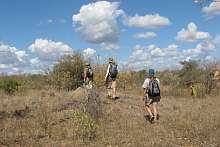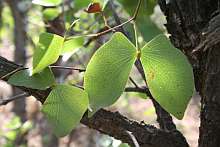The mopane project experience
|
- By Luita Cirone
It was about six weeks ago, during our stay at the beautiful Shimuwini Bush Camp in the Kruger National Park, that my boyfriend Bruce Dinwoodie and I noticed the article in the local circular, calling upon volunteers to participate in the Mopane Tree Mapping project of SAEON. We confirmed our interest and waited with cautious optimism to be contacted.
The experience which we had as volunteers on this project was beyond all expectation. We were afforded the rare, and unique opportunity of accommodated camping at the Section Warden’s residential premises. Our drive to the said premises came complete with various escorts ranging from a porcupine, an elephant, birds, a pack of hyenas, and a fictitious leopard, which was a figment of one of the volunteers’ imagination.
The nights were equally exhilarating. The silence being intermittently broken by the fearsome roar of lions, followed by an afterthought from the hyenas, and various other animal and bird life, served as a constant reminder to us of where we had come to rest. (There was also some snoring coming from a nearby tent, which was loud enough to warrant a mention).
The mopane project was well organised, with the administration being expertly handled by SAEON's Nicola Stevens, and the field management headed by Australian Honours graduate, game ranger, and volunteer herself, Leanne Ezzy. We were easily taken through the theory on what was required from us, and headed off into the bush, under the watchful eye of two veteran rangers.
The team consisted of two couples, who, ideally, walked in the same direction through the bush, about fifty paces apart. We were armed with a compass and hand-held GPS unit, per couple. Leanne managed to alternate between the groups to ensure that the process was running smoothly.
We worked our way from west to east between pre-determined landmarks, and along grids of fifty metres in width, stopping to record the location and density of the mopane trees in the area which we were covering. Although we went off course once or twice, we were afforded the opportunity of learning a little more about this hardy little tree, as well as the areas in which it appeared to be more prolific than others. Perceptions were broadened, and we now eagerly point out, and look for the mopane along with the Big Five.
During the evenings we were graciously allowed to utilise the Section Warden’s lapa facilities, and we spent time getting to know our fellow volunteers (who just happened to come from the same suburb as us), and our team leader, Lea, who tirelessly endured a constant flow of Aussie jokes ranging from rugby to sheep, and Crocodile Dundee, who also got a mention.
In essence it was easy to relate to the other volunteers and to Lea, since we were all like-minded bush loving people with an interest in the environment, completed by the benefit of the knowledge of the expert which we had with us.
We left the project hoping that our small contribution would assist in the conclusion of the greater project, and feeling privileged at having played a small part therein.
|
Related content: SAEON in the media |












